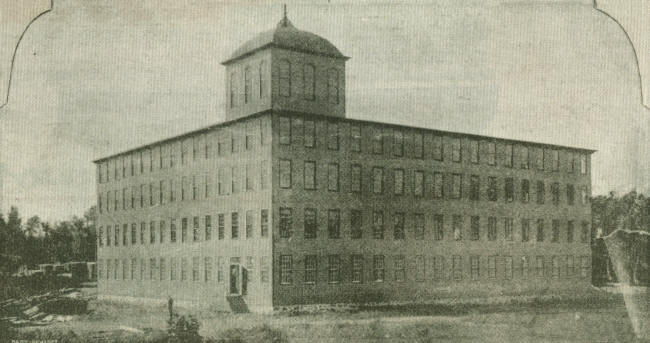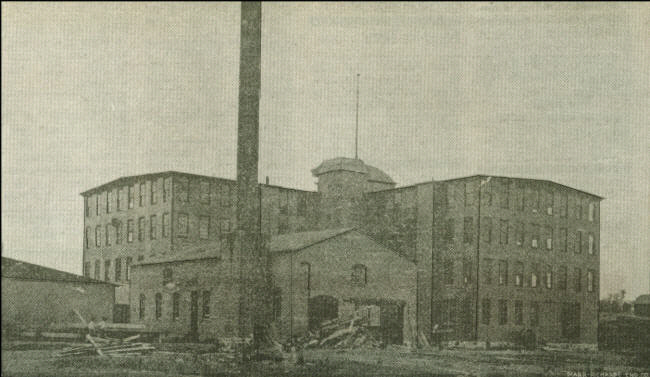|
|
|
Clark County Press, Neillsville, WI March 18, 1993, Page 27 Transcribed by Dolores (Mohr) Kenyon. Index of "Good Old Days" Articles
|
|
|
|
Clark County Press, Neillsville, WI March 18, 1993, Page 27 Transcribed by Dolores (Mohr) Kenyon. Index of "Good Old Days" Articles
|
Good Old Days
Manufacturing companies in Neillsville… now in 1993, Nelson Industries is the largest company. One hundred years ago, the largest factory in the city and area was the Neillsville Furniture Factory located on West 8th Street near O’Neill Creek and Black River.
The furniture factory company was organized by a group of local residents in the year of 1890. Officers of the company were: B. Dangers, president; S. H. Esch, vice-president; C. C. Sniteman, secretary; R. F. Kountz, assistant secretary; Fred Klopf, treasurer; W. G. Klopf, assistant treasurer. The board of directors consisted of: J. H. Beddan, Math Kapellan, George Hernitzicker, Fred Klopf, J. G. Klopf, B. Dangers and C. C. Sniteman.
The capital stock of the company was owned by Clark County people. The building was constructed in the form of an L, 136’x128’x64’, four stories high, with a designing room in the tower portion of the building. The structure had over 51,000 square feet of floor space. It was built on a stone foundation which required 270 cords of stone in the construction. The engine and boiler room was made of solid brick with iron roof, 36’x72’ in size.
The dry house was 53x64 feet, the factory was supplied with the latest equipment available (at that time) being driven by a 225 H.P. Corliss engine. It also had a saw mill powered by a 75 H. P. engine.
The starting capital invested was $64,000. The first order for furniture was a large one and came from London, England. First production in the large building was in 1891. Business for furniture production took off immediately. However, a couple of years later, financial backers ran into financial troubles. Apparently, the new large business needed more operating capital than its directors had anticipated. In order to save the business and their investments, they sold to a group of Baltimore, Maryland businessmen. The Neillsville Furniture Company then received a name change being the Wisconsin Furniture Manufacturing Company of George G. Muhlhenrich, president and Fred Carner as the local manager.
Recovering from the financial score, it quickly went into maximum production. As many as 500 men was the highest employment at one time. Carloads of furniture were shipped by railroad cars, to eastern sales outlets. The pine and hardwood lumber used in making furniture was very accessible in this area at that time.
Business progressed and was in full production with a large work force then on June 28, 1911, in the early hours of that day, a fire was discovered in the building. At 3:55 a.m. the night watchman saw flames through the third floor windows of the building’s northwest corner. Quickly, the alarm was sounded with the company’s own fire-fighting pumps put into action applying four streams of water to the flames. The city volunteer fire department joined with their equipment, pouring additional water on the burning portion. All of the efforts were to no avail as the wooden structure burned quickly as it reached the varnished and finishing rooms on the fourth floor.
Within two hours the large, four story building had been destroyed to ashes and smoldering bits of timber at the foundation level.
The tragic loss of the victory posed the loss of employment for many of the city residents. “A tragedy that affected the entire city, directly or indirectly”
The Wisconsin Furniture Manufacturing Company recovered $38,000 from the insurance company for its loss of completed product. It is not known if fire insurance was carried on the building and its equipment, however it’s presumed there wasn’t as reports mentioned none.
The Neillsville Advancement Association with A. J. Phillips as its representative called a meeting with several hundred people attending. Plans for a fund with pledges from donors began to try to encourage the Baltimore owners to rebuild the factory. Contributions came in, negotiations began, and plans for a new building formulated to the point of construction cost set at $60,000.
All efforts and plans seemed encouraging until the manufacturers wanted city residents to put up $50,000 in addition to their $60,000, to reopen the factory with no pecuniary return.
Local promoters couldn’t raise enough to reach the final $30,000 in bonds for operating expenses of the business. Their efforts fell to no avail when they approached the president asking his consideration to accept that they had reached an amount $10,000 short of the goal.
A short time later, they were notified of the rejection on their proposal. They came close.… but short of realizing their dream of a rebuilt furniture factory in their city which would have once again provided employment for those put out of work due to the fire. The unemployed were forced to find other jobs, some having to relocate in search of employment.
 |
The Neillsville Furniture Factory which was located on West 8th Street near the O’Neill Creek and Black River
This was the front view approaching from the east. The factory first began manufacturing furniture in August of 1891. Wm Morrison, a renowned furniture craftsman, was employed as the superintendent.
 |
The factory as it appeared from the west. The building was of substantial construction. Timber used for the first floor were 14 inches square, second and third floors 12 inches square, and fourth floor 9 inches square. The first floor girders were built to form a truss, there being several pieces of timber used in construction of each, with iron truss rods running from end to end. Floors were four inches thick with inch hardwood flooring on top. There were no inside stairways, access from floor to floor only by outside elevator built in a solid brick shaft, visible on the outside of the building.
(Thanks to Melvin Appleyard for photographs and information.) (A correction on the Stelloh story of two weeks ago: Fred Stelloh’s second marriage was to Elsie Glass. Elsie had a daughter, Mercides.)
¤¤¤¤¤¤¤¤¤¤¤¤¤¤¤¤¤¤¤¤¤¤¤¤
Compiled by Terry Johnson
FIFTY YEARS AGO
At the Adler Theatre, a special matinee was scheduled with admission for children under 12 years of age costing “4-oz. or more of copper scrap.” A cartoon being shown was called, “Scrap for Victory.” Features scheduled at Adler were: “Forest Rangers (with Fred MacMurray, Paulette Goddard and Susan Hayward, and “In Old California,” starring John Wayne and Binnie Barnes. Old California was “out where men fought for gold and glory.”
An American Stores Dairy Co. ad advised; “Whirl the Can, To Get Good Milk.” A good way to cool milk, winter or summer, is to whirl the can in the water tank. The effect of this whirling is to stir the milk in the can, thus bring the warm milk from the center to the side, and to agitate the water, so that the warmer water near the can is replaced with the colder water which rushes in. The effect of the whirling, in cold water, is to bring the temperature down rapidly and to prevent the growth of bacteria.”
In Cannonville news: “Bernard Kuhn has purchased a new milking machine.”
“Mats Madsen, redoubtable wrestler of Neillsville and a man handy with his dukes let a Medford man leave town all in one piece after that Medford man had slapped his face twice and put him down on the floor. The happy and whole departure of the Medford man was due to the gallantry of Madsen, who declared that he would not fight a man in his cups.”
ONE HUNDRED YEARS AGO
“Opera House and Armory Ball: The grand ball last evening given by the members of the Co. A, in celebration of the opening of Neillsville’s new opera house and armory marked the high tide of social affairs in the city’s history…. The number of tickets sold was142. The large floor was covered with the dancers, and the gallery thronged with those who came to see.
…Hon. James O’Neill made a short address by way of formal dedication, recounting the city’s history in hall building, and bidding the guests welcome.”
A list of the ladies at the ball, along with descriptions of their gowns was printed. It ran almost one entire column. Probably the most elegant was “Mrs. James O’Neill, black ottoman, with orange velvet, ostrich trimmings, diamond ornaments.” Another: “Mrs. H. M. Root, iridescent tabliers on gown of old blue bengaline en train.” Miss Ollie Huntzicker wore “brocaded crepe du chine (yellow), with black chantilly.”
On Monday evening, March 13, 1893, the Neillsville Advancement Association adopted its constitution and by-laws. The preamble read: “In order to foster and promote the growth and welfare of the city of Neillsville and advance its interests, and establish such customs, rules and regulations as may appear to be the highest benefit to our said city, which can only be attained by united efforts and concerted action by its citizens, for the reasons we, the undersigned, hereby resolve ourselves into an organization to be known as the Neillsville Advancement Association.”
|
© Every submission is protected by the Digital Millennium Copyright Act of 1998.
Show your appreciation of this freely provided information by not copying it to any other site without our permission.
Become a Clark County History Buff
|
|
A site created and
maintained by the Clark County History Buffs
Webmasters: Leon Konieczny, Tanya Paschke, Janet & Stan Schwarze, James W. Sternitzky,
|